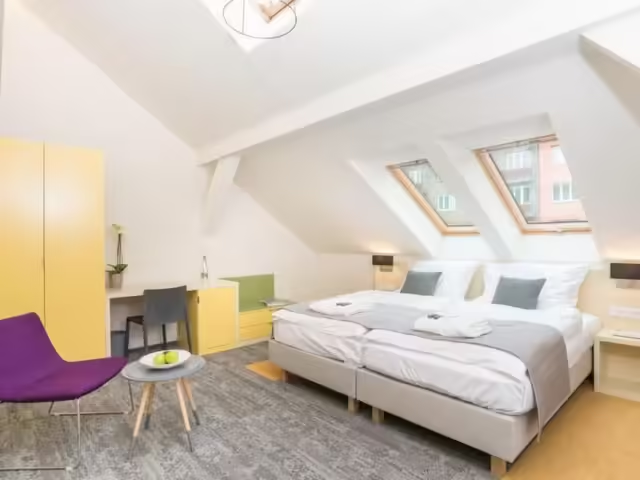Powder Tower

Address
Nám. Republiky 5, 110 00 Staré Město, Czechia
GPS
50.08775565, 14.427763665259
The Powder Tower Gate (Prašná brána), one of Prague’s most evocative late-Gothic landmarks, was constructed to replace the original, deteriorating Horská Gate (modelled after the town of Kutná Hora) in the early 13th century. One of the most important routes into town came from Kutná Hora in Eastern Bohemia, and it was guarded by the Powder Gate Tower.
It was also via this gate that the coronation processions of Bohemian kings entered the city. As such, the Coronation or Royal Path to Prague Castle officially begins at the Powder Gate Tower.
Construction began in 1475 under the direction of builder Václav, and continued beginning in 1478 under the direction of Matej Rejsek, who also contributed to the lavish sculptural decorations. The tower’s foundation is about 9 metres below the current ground level, at the bottom of a fortification moat.
 The bridge that had linked to the passageway vanished after the moat was filled in and its significance was no longer recognised. From 1488 on, construction on the gate halted, most likely because the royal residence had been relocated from the Old Town to the Castle.
The bridge that had linked to the passageway vanished after the moat was filled in and its significance was no longer recognised. From 1488 on, construction on the gate halted, most likely because the royal residence had been relocated from the Old Town to the Castle.
In 1592, during Mayor Krocn of Drahobejl’s tenure, construction on the new entryway and spiral staircase (which is still in use today) began. Before that, the only way in was through the Royal Court’s (Královsk dvr) gallery. Powder Gate Tower, formerly known as New Tower, has been known by its current name since the early 18th century, when it served as a gunpowder storage facility.
All the plastic ornaments were shot up by the Prussians in 1757, and by 1817 they had all been taken down. There was formerly a clock in the tower, but it was taken out in 1823. The Powder Gate Tower was repaired and finished in pseudo-Gothic style between 1875 and 1886 by architect Josef Mocker and notable Bohemian sculptors including Bohuslav Schnirch and Ludvk imek.
The builder used a spectacular vault on the first story and a net vault on the second. The gateway is complete with a gallery and chisel ceiling, and the passageway is vaulted with a net. On the side facing Celetná Street, statues of Ji of Podbrady and Vladislav II stand guard, while on the side facing Pemysl Otakar II and Charles IV stand guard.
The royal sculptures are encircled by the coats of arms of the countries they ruled. The monarchs’ virtues are portrayed as allegories in the corners. The statues of the rulers are topped with winged angels, and the four corner posts each feature a lion holding the Old Town of Prague’s symbol.
 Christ stands at the centre of the statues honouring Bohemian patrons and saints, which can be found on the eastern side of the building, and the Virgin Mary and her child may be found on the western side. Adam and Eve statues can be seen on the side facing Celetná Street, while St. Peter and Paul icons can be found on the side facing the opposite street.
Christ stands at the centre of the statues honouring Bohemian patrons and saints, which can be found on the eastern side of the building, and the Virgin Mary and her child may be found on the western side. Adam and Eve statues can be seen on the side facing Celetná Street, while St. Peter and Paul icons can be found on the side facing the opposite street.
By the battlement are emblems of the royal towns of Bohemia. Above the Eastern doorway is a bust of a knight with the Latin words “Behold! Prague” inscribed on a ring around his neck. I am a mother to the truthful and a stepmother to the dishonest; those who seek evil should run, while those seeking good should approach.
Matej Rejsek’s bust may be found on the western side, and it features a band with the following Latin plea: “Dear citizen, forbear the unworthy people living without laws from harming me, a fine receptacle.” Gothic plastic decorations depicting slightly scandalous scenarios have been discovered on the exterior of the building adjacent to the Municipal house.
There is a unique bay on the side away from the Municipal building that was formerly used as a lavatory. Visitor inscriptions, the earliest of which date to 1821 and 1844, cover the gallery’s slate roof, which features four corner spires that are each 6 m in height.
Rebuilding began in 1961 and continued until 1963, with some of the sculptures being reconstructed in 1992.
Powder Tower Gate has a total height of 65 metres, an observation gallery at an altitude of 44 metres, and a stairwell with 186 stone steps.












